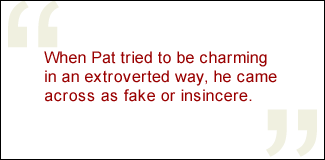There's nothing more crucial to success in business than an ability to influence others. Salespeople need to influence customers; executives must influence their workforces; upwardly mobile, ambitious employees seek to influence the managers who can help them ascend the corporate ladder. Wherever you are on the organization chart, it's essential to consider how you exercise influence.
 |
One of the best ways to improve your ability to influence other people is to better understand your talents -- and how you can positively apply those talents to the act of influencing.
But first, a few words on how not to influence people. You may have had an experience when someone who has obviously attended a seminar on "how to influence others" has chosen you as the "other" on whom to practice his newfound skills. And when this person tried to apply a technique such as "laying on the charm," it was clear that he was not naturally a very charming person. The result was annoyance rather than influence.
So when it comes to influencing others, instead of imitating that person and trying to be someone you are not, it's much more effective to be who you naturally are. To illustrate this point, I would like to tell you about Pat. Pat owns a supply business, and he must influence the people who work for him to maximize production and create a great workplace. He also needs to influence his clients so they'll recognize the value of his products and services and ultimately purchase them.
The introvert
Pat had actually attended one of those how-to-influence-others seminars, and he was told that "charm" was the key to success. Now, that may be true for some people, but not for Pat. By nature, Pat is introverted. When, as a result of the seminar, he tried to be charming in an extroverted way, he came across as fake or insincere.
Pat later learned from a strengths coach that being influential or even charming can be achieved in many different ways -- and that the best way for Pat to be charming or influential would probably be different than it would be for someone else. Pat also took the Clifton StrengthsFinder, a 180-item online assessment that measures a person's talents in 34 categories, referred to as "themes," and reveals the user's top five themes. Pat was able to use what he learned from the assessment, as well as what he learned from the strengths coach, to more effectively apply his greatest talents when influencing others.
Two of Pat's top Clifton StrengthsFinder themes are Individualization and Belief. People who are highly talented in Individualization are exceptionally able to appreciate the uniqueness of each person they meet, while people with powerful Belief talents tend to be drawn to endeavors that have a strong sense of purpose or mission connected to them.
Pat's strengths coach helped him understand how he applied talents from these two particular themes to his daily life. Then they explored how he could use those talents when influencing others.
Showing that he cared
Once Pat understood his talents -- and how he could use them to influence others positively -- his interactions with his customers changed profoundly. For example, Pat had been trying to sell a new product to one of his clients, but the client was reluctant to try it. The client attributed this resistance to price, even though Pat had explained that when factoring in discounts, volume pricing, and the new product's overall quality, the customer would ultimately save money.
Despite Pat's reasoning, the client kept resisting, so Pat decided to leverage his greatest talents. Drawing on his Belief talents, Pat said to his client, "I really want you to do what is right for you" -- and he meant it; doing right by his clients is an essential part of Pat's sense of mission. Using his Individualization talents, Pat was motivated to probe what was troubling this particular client in this specific situation.
"I sense there is more to this than price," Pat said. "Please tell me what else is holding you back from making the change, because in the long run, I think it's in your best interest to switch to the new product."
The client finally admitted that it was a packaging issue. The new product was shipped four to a box rather than two. This meant the client would have to spend more time to split the packages, or he would have to reconfigure his entire stock area to accommodate the different packaging. Pat asked the client why he hadn't told him this before. The client, recalling the way Pat used to "lay on the charm," replied, "I didn't think you really cared before."
What made that moment so powerful for Pat was that he realized that in the past, when he had tried to be someone he wasn't, his clients detected his insincerity; the "charm" approach didn't ring true. But by tapping into his talents, Pat was able to reconnect with his client. And in the end, Pat not only convinced the client to move to the new product -- he also influenced the supplier to move to a different packaging scheme.